 Technology peripherals
Technology peripherals
 AI
AI
 Don't know how to deploy machine learning models? 15 pictures take you into the TensorFlow deployment framework!
Don't know how to deploy machine learning models? 15 pictures take you into the TensorFlow deployment framework!
Don't know how to deploy machine learning models? 15 pictures take you into the TensorFlow deployment framework!

Opening Chapter
A few days ago, I chatted with a friend Xiao Li who has been engaged in development for 3 years and learned that his company is conducting research related to machine learning. project. Recently, he received a task to deploy the trained machine learning model. This worries Xiao Li. He has been involved in machine learning development for almost half a year. He is mainly engaged in data collection, data cleaning, environment building, model training, and model evaluation. However, this is his first time doing model deployment.
So, I conducted popular science on machine learning model deployment based on my own experience. As shown in Figure 1, in traditional programming, we pass rules and data to the program to get the answers we want. For machine learning, we train the rules through the answers and data. This rule is the model of machine learning. .
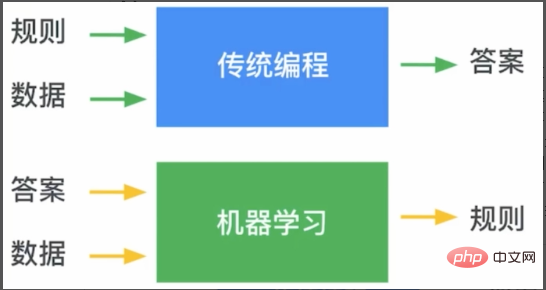
Figure 1 The difference between traditional programming and machine learning
And the model deployment of machine learning is to Deploy this rule (model) to the endpoint where machine learning needs to be applied. As shown in Figure 2, the model trained by machine learning can be understood as a function, API or SDK, and is deployed on the corresponding terminal (the gray part in the figure). After deployment, the terminal will have the capabilities given by the model. At this time, by inputting new data, the predicted results can be obtained according to the rules (model).
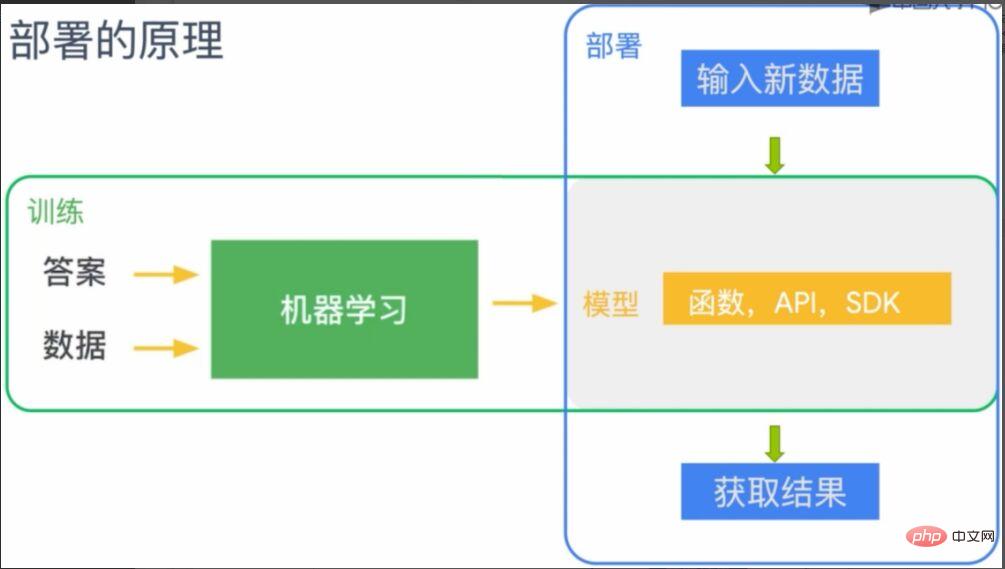
Figure 2 Principle of machine learning model deployment
TensorFlow machine learning deployment framework
Xiao Li said he understood after listening to my introduction, and told me all about the deployment of their project with great interest, and wanted to ask for my opinion. As shown in Figure 3, they want to deploy an image recognition model to IOS, Android, Raspberry Pi, web browser and server side.
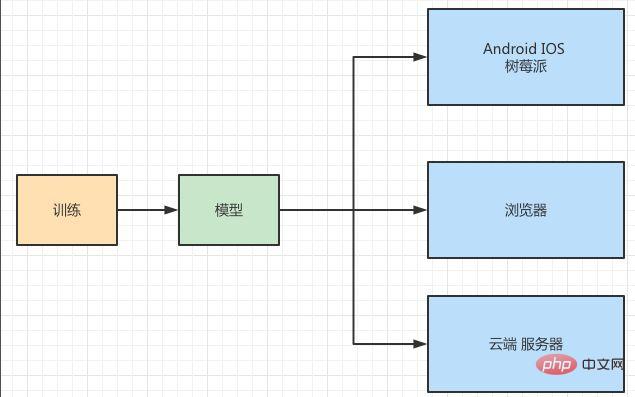
Figure 3 Model deployment scenario
From the deployment application scenario, it is lightweight , cross-platform features. The same machine learning model needs to be deployed on multiple different platforms, and each platform has different storage and computing capabilities. At the same time, the availability, performance, security, and scalability of model operation must be taken into consideration, and a relatively stable large platform needs to be used. So, I recommended TensorFlow’s machine learning deployment framework to him. As shown in Figure 4, TensorFlow's deployment framework provides component support for different platforms. Among them, Android, IOS, and Raspberry Pi correspond to TensorFlow Lite, which is a model deployment framework specially used for mobile terminals. The browser side can use TensorFlow.js, and the server side can use TensorFlow Serving.
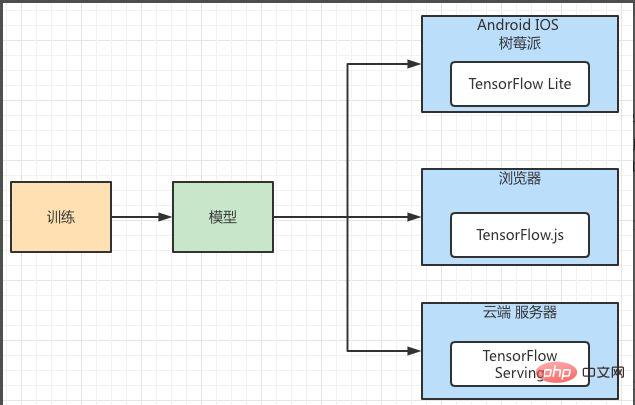
Figure 4 TensorFlow machine learning model deployment framework
TensorFlow Lite actual operation
小李 wanted to know a more specific deployment process. I happened to have a project that used TensorFlow's deployment framework, so I demonstrated the process to him. This project is to deploy the "cat and dog recognition" model to Android phones. Since IOS, Android, Raspberry Pi, and browsers are all clients, their computing resources cannot be compared with those of the server. In particular, mobile applications have the characteristics of lightweight, low latency, high efficiency, privacy protection, power saving, etc., so TensorFlow has specially designed their deployment and uses TensorFlow Lite to deploy them.
Using TensorFlow Lite to deploy a model requires three steps:
- Use TensorFlow to train the model.
- Convert to TensorFlow Lite format.
- Use the TensorFlow Lite interpreter to load and execute.
In the first step, we have completed the model training. The second step is to convert the generated model into a pattern format that TensorFlow Lite can recognize and use. As mentioned above, when the model is used on the mobile terminal, various issues need to be considered, so a special file format needs to be generated for the mobile terminal. The third step is to load the converted TensorFlow Lite file into the mobile interpreter and execute it.
Since our focus is on model deployment, the first step of training the model is temporarily skipped, which means that you have already trained the model. For the second step of model conversion, please refer to Figure 5. The TensorFlow model will be converted into a model file with the suffix ".tflite" through Converter, and then published to different platforms, and processed through the interpreter on each platform. Explain and load.
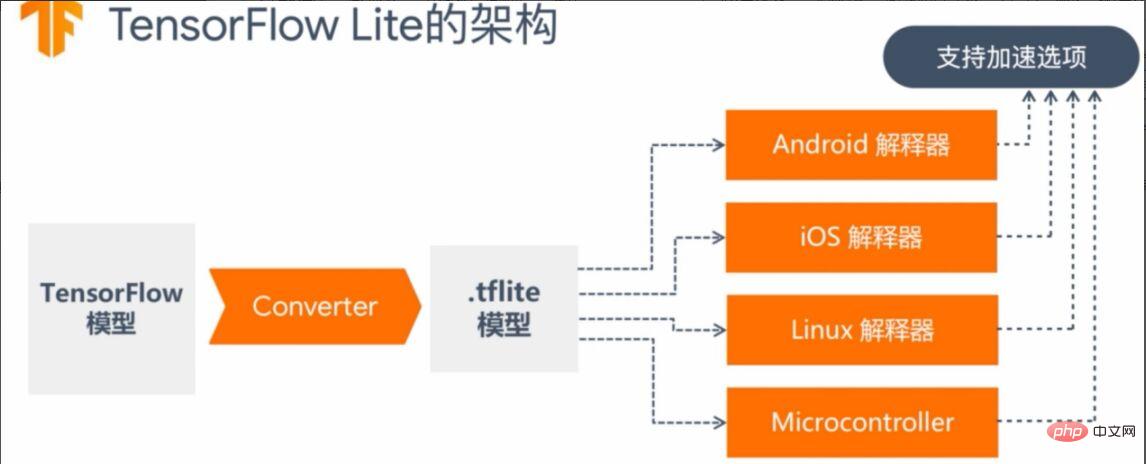
Figure 5 TensorFlow Lite model conversion architecture
Model saving and conversion
The architecture of TensorFlow Lite is introduced above. Here you need to save the model as a TensorFlow model and convert it. As shown in Figure 6, we call the saved_model.save method in TensorFlow to save the model (trained model) in the specified directory.
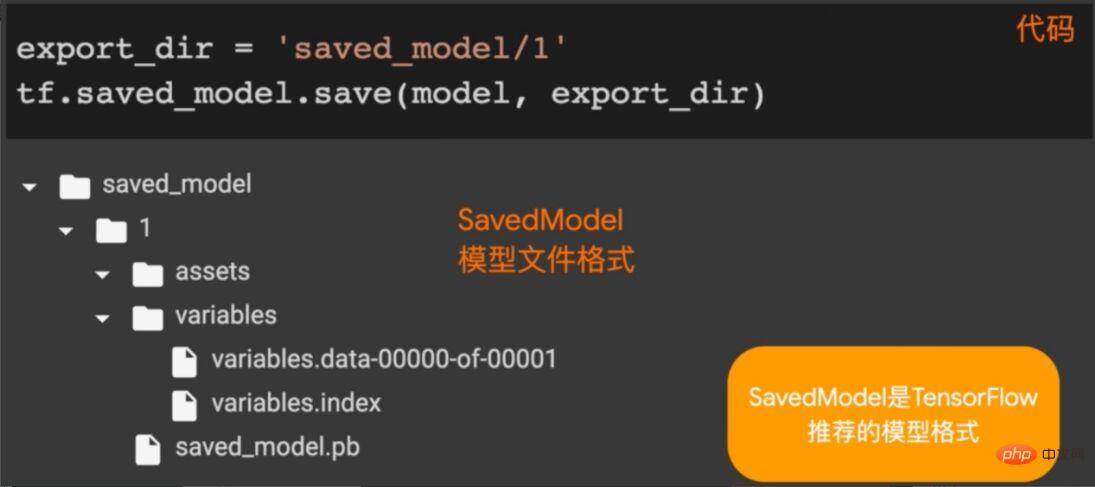
Figure 6 Saving the TensorFlow model
After saving the model, it is time to convert the model, as shown in Figure 7 As shown, call the from_saved_model method in the TFLiteConverter package in TensorFlow Lite to generate an instance of the converter (model converter), then call the convert method in the converter to convert the model, and save the converted file to the specified directory.
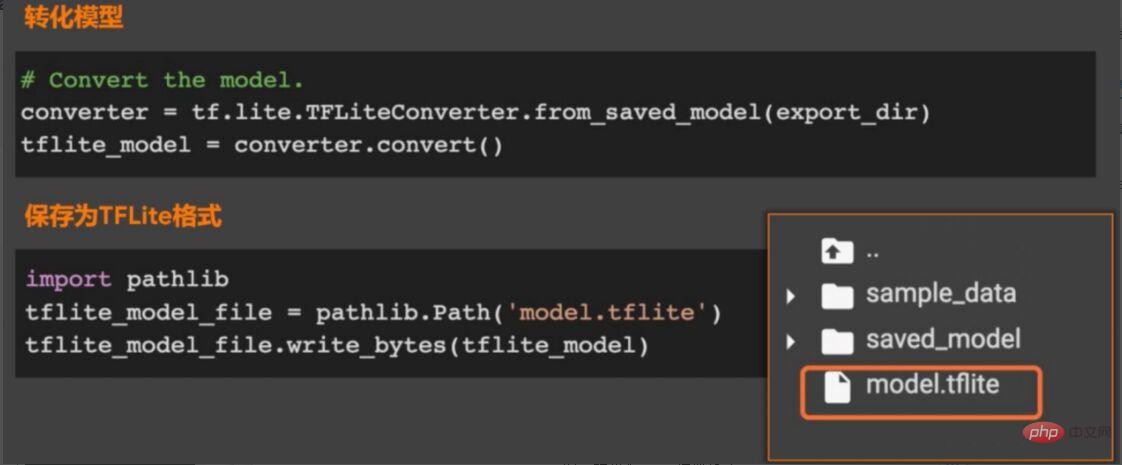
Figure 7 Convert to tflite model format
Load application model
Because This example is for model deployment on the Android system, so the dependency of TensorFlow Lite needs to be introduced in Android. As shown in Figure 8, introduce the dependency of TensorFlow Lite, and set noCompress to "tflite" in aaptOptions, which means that files with "tflite" will not be compressed. If compression is set, the Android system may not recognize tflite files.
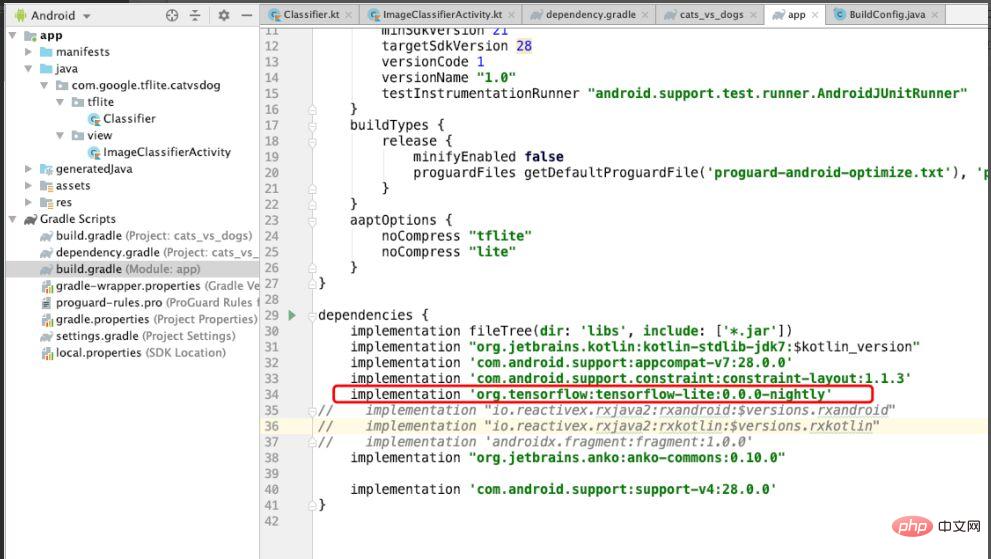
Figure 8 Dependencies introduced to TensorFlow Lite in the project
After configuring the dependencies, convert Copy the good tflite file to the assets file, as shown in Figure 9. This file will be loaded later to execute the machine learning model.
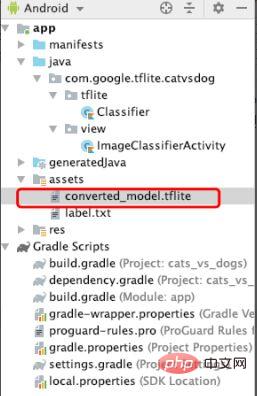
Figure 9 Add tflite file
After adding the tflite file, we will create the Classifier classifier , used to classify “cat and dog” pictures. As shown in Figure 10, the interpreter is initialized in init in Classifer, the loadModuleFlie method is called to load the tflite file, and the classification label (labelList) is specified. The label here is "cat dog".
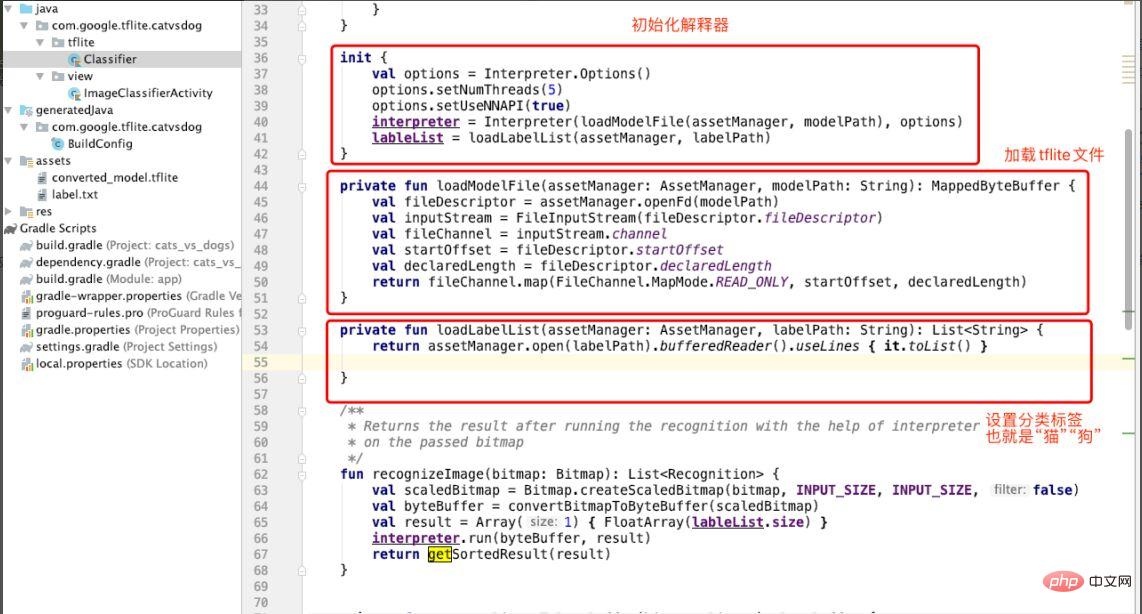
Figure 10 Initializing the interpreter
After creating the classifier, the cat and dog classification model is used to identify the image. That is, in the Classifier class, as shown in Figure 10, the input parameter of the convertBitmapToByteBuffer method is bitmap. This is the picture of the cat and dog we input. It will be converted in this method. Pay special attention to the red in the for loop. Convert the green and blue channels, put the conversion result into a byteBuffer and return it. The recoginzeImage method calls convertBitmapToByteBuffer and uses the run method of the interpreter to perform image recognition work, that is, using a machine learning model to identify images of cats and dogs.
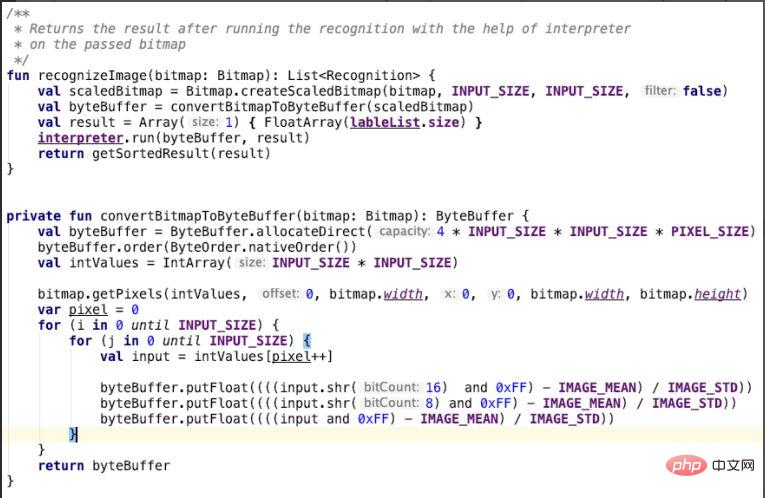
Figure 11 Recognizing pictures
The above graphic transformation process is too abstract, we will The details are shown in Figure 12. The image we input is the 395*500 image in the upper left corner of the picture, which will convert the image in the imageView into bitmap form. Since our model input requires a 224*224 format, a conversion is required. Next, the pixels are put into a 224*224 ByteBuffer array and saved, and finally the RGB (red, green, and blue) pixels are normalized (divided by 255) as the input parameters of the model.
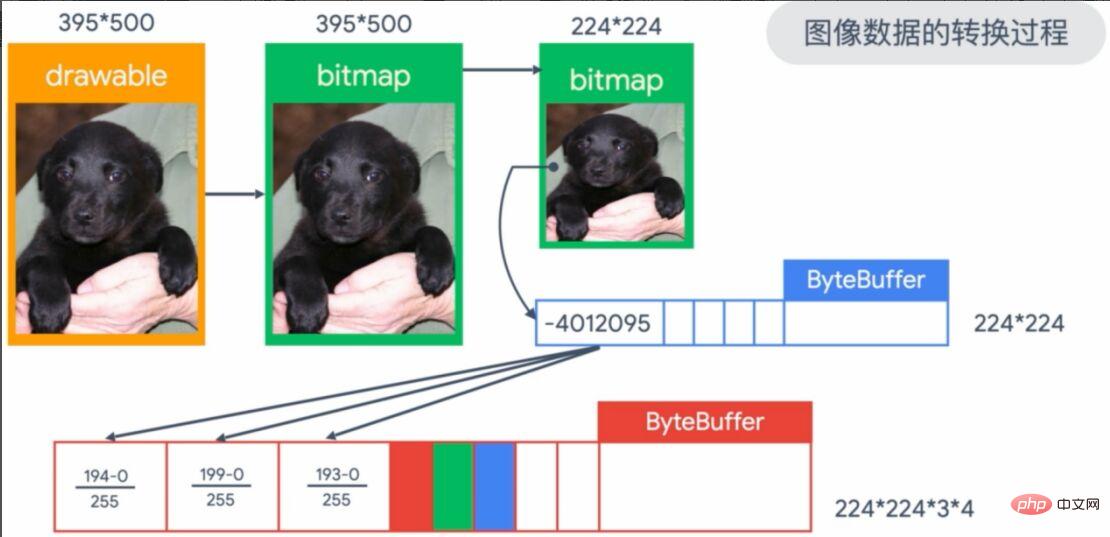
Figure 12 Conversion process of input image
At this point, the loading and application of the machine learning model is complete Complete, of course, the input files and layout are indispensable. As shown in Figure 13, we store the pictures that need to be predicted (cat and dog pictures) under the drawable folder. Then create the activity_image_classifier.xml file under the layout to build and store the ImageView.
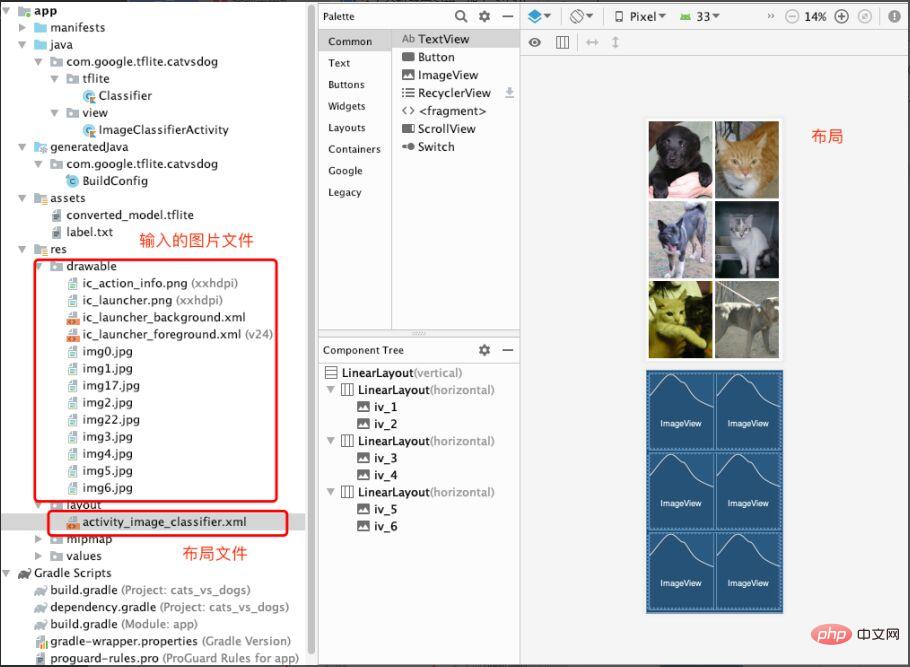
Figure 13 Input image files and layout files
Finally, create ImageClassifierActivity to display images and Respond to events that identify images. As shown in Figure 14, bind the onclick event of each image in the initViews method, and then call the recoginzie Image method in the onclick method to identify the image.
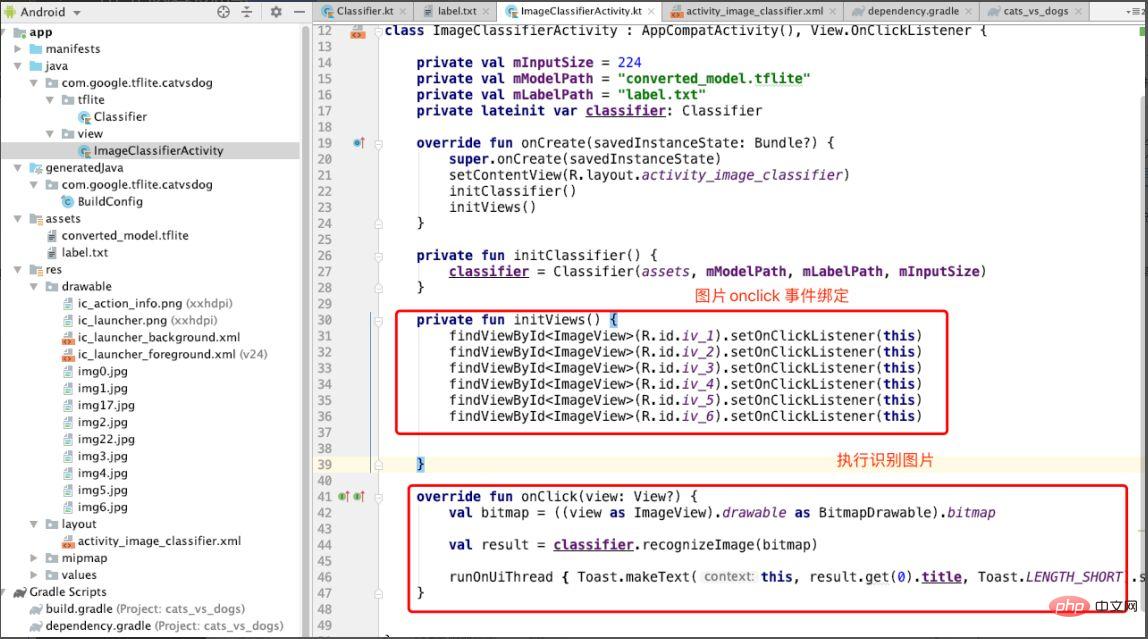
Figure 14 Perform image recognition in onclick
Let’s take a look at the effect. As shown in Figure 15, when the corresponding picture is clicked, a "dog" prompt will be displayed, indicating the prediction result.
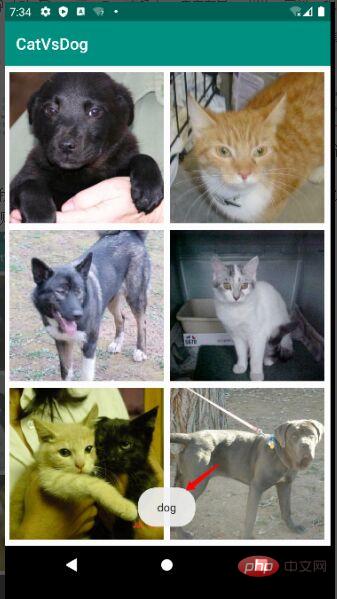
Figure 15 Demonstration effect
Reviewing the whole process is not complicated, I will deploy the model with TensorFlow lite It is summarized in the following steps:
- Save the machine learning model.
- Convert the model to tflite format.
- Load the model in tflite format.
- Use the interpreter to load the model.
- Input parameter prediction results.
Students who want to further learn TensorFlow model deployment skills can learn TensorFlow’s official courses, register an account on the Chinese University MOOC, and learn for free: https://www.php.cn/link/1f5f6ad95cc908a20bb7e30ee28a5958
There are also Google developer experts to do it The online explanation and Q&A on deployment are very good. It is recommended that students who want to get a preliminary understanding of TensorFlow deployment function pay attention to https://www.php.cn/link /e046ede63264b10130007afca077877f
End
After Xiao Li listened to my explanation of machine learning model deployment and understood the process of TensorFlow deployment, he was even more eager to try the practical deployment. I think the deployment process using TensorFlow is logically clear, the method is simple and easy to implement, and it is easy for developers with 3-5 years of experience to get started. In addition, TensorFlow officially provides the "TensorFlow Introductory Practical Course", which is suitable for novices with zero foundation in machine learning: https://www.php.cn/link/bf2fe6582ed9ead9161a3d6f6b1d6858
Author Introduction
Cui Hao, 51CTO community editor, senior architect, has 20 years of architecture experience. He once served as a technical expert at HP, participated in multiple machine learning projects, and wrote and translated more than 20 popular technical articles on machine learning, NLP, etc. Author of "Principles and Practice of Distributed Architecture".
The above is the detailed content of Don't know how to deploy machine learning models? 15 pictures take you into the TensorFlow deployment framework!. For more information, please follow other related articles on the PHP Chinese website!

Hot AI Tools

Undresser.AI Undress
AI-powered app for creating realistic nude photos

AI Clothes Remover
Online AI tool for removing clothes from photos.

Undress AI Tool
Undress images for free

Clothoff.io
AI clothes remover

Video Face Swap
Swap faces in any video effortlessly with our completely free AI face swap tool!

Hot Article

Hot Tools

Notepad++7.3.1
Easy-to-use and free code editor

SublimeText3 Chinese version
Chinese version, very easy to use

Zend Studio 13.0.1
Powerful PHP integrated development environment

Dreamweaver CS6
Visual web development tools

SublimeText3 Mac version
God-level code editing software (SublimeText3)

Hot Topics
 Bytedance Cutting launches SVIP super membership: 499 yuan for continuous annual subscription, providing a variety of AI functions
Jun 28, 2024 am 03:51 AM
Bytedance Cutting launches SVIP super membership: 499 yuan for continuous annual subscription, providing a variety of AI functions
Jun 28, 2024 am 03:51 AM
This site reported on June 27 that Jianying is a video editing software developed by FaceMeng Technology, a subsidiary of ByteDance. It relies on the Douyin platform and basically produces short video content for users of the platform. It is compatible with iOS, Android, and Windows. , MacOS and other operating systems. Jianying officially announced the upgrade of its membership system and launched a new SVIP, which includes a variety of AI black technologies, such as intelligent translation, intelligent highlighting, intelligent packaging, digital human synthesis, etc. In terms of price, the monthly fee for clipping SVIP is 79 yuan, the annual fee is 599 yuan (note on this site: equivalent to 49.9 yuan per month), the continuous monthly subscription is 59 yuan per month, and the continuous annual subscription is 499 yuan per year (equivalent to 41.6 yuan per month) . In addition, the cut official also stated that in order to improve the user experience, those who have subscribed to the original VIP
 Context-augmented AI coding assistant using Rag and Sem-Rag
Jun 10, 2024 am 11:08 AM
Context-augmented AI coding assistant using Rag and Sem-Rag
Jun 10, 2024 am 11:08 AM
Improve developer productivity, efficiency, and accuracy by incorporating retrieval-enhanced generation and semantic memory into AI coding assistants. Translated from EnhancingAICodingAssistantswithContextUsingRAGandSEM-RAG, author JanakiramMSV. While basic AI programming assistants are naturally helpful, they often fail to provide the most relevant and correct code suggestions because they rely on a general understanding of the software language and the most common patterns of writing software. The code generated by these coding assistants is suitable for solving the problems they are responsible for solving, but often does not conform to the coding standards, conventions and styles of the individual teams. This often results in suggestions that need to be modified or refined in order for the code to be accepted into the application
 Seven Cool GenAI & LLM Technical Interview Questions
Jun 07, 2024 am 10:06 AM
Seven Cool GenAI & LLM Technical Interview Questions
Jun 07, 2024 am 10:06 AM
To learn more about AIGC, please visit: 51CTOAI.x Community https://www.51cto.com/aigc/Translator|Jingyan Reviewer|Chonglou is different from the traditional question bank that can be seen everywhere on the Internet. These questions It requires thinking outside the box. Large Language Models (LLMs) are increasingly important in the fields of data science, generative artificial intelligence (GenAI), and artificial intelligence. These complex algorithms enhance human skills and drive efficiency and innovation in many industries, becoming the key for companies to remain competitive. LLM has a wide range of applications. It can be used in fields such as natural language processing, text generation, speech recognition and recommendation systems. By learning from large amounts of data, LLM is able to generate text
 Can fine-tuning really allow LLM to learn new things: introducing new knowledge may make the model produce more hallucinations
Jun 11, 2024 pm 03:57 PM
Can fine-tuning really allow LLM to learn new things: introducing new knowledge may make the model produce more hallucinations
Jun 11, 2024 pm 03:57 PM
Large Language Models (LLMs) are trained on huge text databases, where they acquire large amounts of real-world knowledge. This knowledge is embedded into their parameters and can then be used when needed. The knowledge of these models is "reified" at the end of training. At the end of pre-training, the model actually stops learning. Align or fine-tune the model to learn how to leverage this knowledge and respond more naturally to user questions. But sometimes model knowledge is not enough, and although the model can access external content through RAG, it is considered beneficial to adapt the model to new domains through fine-tuning. This fine-tuning is performed using input from human annotators or other LLM creations, where the model encounters additional real-world knowledge and integrates it
 Five schools of machine learning you don't know about
Jun 05, 2024 pm 08:51 PM
Five schools of machine learning you don't know about
Jun 05, 2024 pm 08:51 PM
Machine learning is an important branch of artificial intelligence that gives computers the ability to learn from data and improve their capabilities without being explicitly programmed. Machine learning has a wide range of applications in various fields, from image recognition and natural language processing to recommendation systems and fraud detection, and it is changing the way we live. There are many different methods and theories in the field of machine learning, among which the five most influential methods are called the "Five Schools of Machine Learning". The five major schools are the symbolic school, the connectionist school, the evolutionary school, the Bayesian school and the analogy school. 1. Symbolism, also known as symbolism, emphasizes the use of symbols for logical reasoning and expression of knowledge. This school of thought believes that learning is a process of reverse deduction, through existing
 To provide a new scientific and complex question answering benchmark and evaluation system for large models, UNSW, Argonne, University of Chicago and other institutions jointly launched the SciQAG framework
Jul 25, 2024 am 06:42 AM
To provide a new scientific and complex question answering benchmark and evaluation system for large models, UNSW, Argonne, University of Chicago and other institutions jointly launched the SciQAG framework
Jul 25, 2024 am 06:42 AM
Editor |ScienceAI Question Answering (QA) data set plays a vital role in promoting natural language processing (NLP) research. High-quality QA data sets can not only be used to fine-tune models, but also effectively evaluate the capabilities of large language models (LLM), especially the ability to understand and reason about scientific knowledge. Although there are currently many scientific QA data sets covering medicine, chemistry, biology and other fields, these data sets still have some shortcomings. First, the data form is relatively simple, most of which are multiple-choice questions. They are easy to evaluate, but limit the model's answer selection range and cannot fully test the model's ability to answer scientific questions. In contrast, open-ended Q&A
 SOTA performance, Xiamen multi-modal protein-ligand affinity prediction AI method, combines molecular surface information for the first time
Jul 17, 2024 pm 06:37 PM
SOTA performance, Xiamen multi-modal protein-ligand affinity prediction AI method, combines molecular surface information for the first time
Jul 17, 2024 pm 06:37 PM
Editor | KX In the field of drug research and development, accurately and effectively predicting the binding affinity of proteins and ligands is crucial for drug screening and optimization. However, current studies do not take into account the important role of molecular surface information in protein-ligand interactions. Based on this, researchers from Xiamen University proposed a novel multi-modal feature extraction (MFE) framework, which for the first time combines information on protein surface, 3D structure and sequence, and uses a cross-attention mechanism to compare different modalities. feature alignment. Experimental results demonstrate that this method achieves state-of-the-art performance in predicting protein-ligand binding affinities. Furthermore, ablation studies demonstrate the effectiveness and necessity of protein surface information and multimodal feature alignment within this framework. Related research begins with "S
 SK Hynix will display new AI-related products on August 6: 12-layer HBM3E, 321-high NAND, etc.
Aug 01, 2024 pm 09:40 PM
SK Hynix will display new AI-related products on August 6: 12-layer HBM3E, 321-high NAND, etc.
Aug 01, 2024 pm 09:40 PM
According to news from this site on August 1, SK Hynix released a blog post today (August 1), announcing that it will attend the Global Semiconductor Memory Summit FMS2024 to be held in Santa Clara, California, USA from August 6 to 8, showcasing many new technologies. generation product. Introduction to the Future Memory and Storage Summit (FutureMemoryandStorage), formerly the Flash Memory Summit (FlashMemorySummit) mainly for NAND suppliers, in the context of increasing attention to artificial intelligence technology, this year was renamed the Future Memory and Storage Summit (FutureMemoryandStorage) to invite DRAM and storage vendors and many more players. New product SK hynix launched last year





